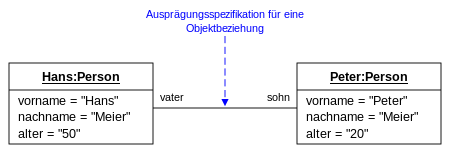Object diagram
| Structure diagrams of the UML |
|---|
| Class diagram |
| Component diagram |
| Composition structure diagram |
| Object diagram |
| Package diagram |
| Profile diagram |
| Distribution diagram |
| UML behavioral diagrams |
| Activity diagram |
| Use case diagram |
| Interaction overview diagram |
| Communication diagram |
| Sequence diagram |
| Timing diagram |
| State diagram |
An object diagram (Engl. Object diagram ) is one of the 14 chart types in the Unified Modeling Language (UML), a modeling language for software and other systems.
The object diagram is a structure diagram because it shows the structure of the modeled system for a limited period of time or a specific point in time (snapshot). The representation typically includes specification specifications of classes and associations . The object diagram can display the assignment of the attributes for the displayed characteristics specifications . Since the number of attributes can be very large, it is possible to only list certain attributes that are sufficient for the purpose that you want to clarify.
The structure of the object diagram is similar to the class diagram , except that in the top box there is not "only" the bold classifier name or class name, but [Instanzname] : [Classifiername bzw. Typ]underlined. The instance name is optional and can be omitted for unnamed (anonymous) objects. If no classifier name is known, this can also be omitted. In the same way - unlike in many programming languages - several classifiers (separated by commas) can be specified at once.
Examples
The figure on the left shows an object diagram with characteristic specifications for two characteristics of the class Personand an object relationship between these characteristics.
Individual evidence
- ↑ Bernhard Rumpe: Modeling with UML . 2nd edition, Springer, 2011, Section 4.2.1 Incompleteness and exemplarity
literature
- Christoph Kecher: UML 2.0 - The comprehensive manual . Galileo Computing, 2006, ISBN 3-89842-738-2 .
- Heide Balzert: Textbook of Object Modeling - Analysis and Design with UML 2 . Elsevier Spectrum Academic Publishing House, 2005, ISBN 3-8274-1162-9 .
- Chris Rupp , Stefan Queins, Barbara Zengler: UML 2 crystal clear . Hanser Verlag, 2007, ISBN 978-3-446-41118-0 .
